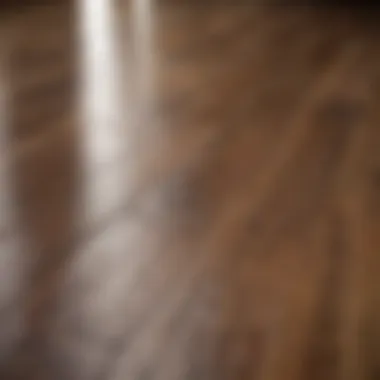Enhancing Wood Floors with Mineral Oil Maintenance


Intro
Maintaining the beauty and longevity of wood floors is a priority for many homeowners. They want floors that look pristine and are functional in their daily lives. Mineral oil serves as a viable option in this realm. This article dissects the role mineral oil plays in wood floor maintenance, detailing its properties and applications.
Mineral oil is often celebrated for its ability to enhance the aesthetics of wooden surfaces while providing protective benefits. Its unique characteristics make it suitable for various types of wood, especially softer varieties. Understanding how to apply mineral oil properly can ensure that wood floors remain attractive over time. Additionally, discussing its eco-friendliness and safety will be addressed.
To establish a comprehensive understanding, the subsequent sections will cover:
- Properties of mineral oil
- Best practices for application
- Advantages and potential drawbacks
- Environmental considerations
- The relationship between mineral oil and wood floor visuals
By exploring these facets, we aim to equip homeowners and design enthusiasts with significant knowledge on maintaining and beautifying their wood floors using mineral oil—an accessible and effective approach.
Prologue to Mineral Oil and Wood Floors
The maintenance of wood floors is often overlooked but crucial for preserving their beauty and longevity. Using mineral oil in this process presents a practical solution for homeowners. In this section, we aim to unpack the significance of mineral oil, highlighting its specific benefits and considerations in wood floor care.
Understanding Mineral Oil
Mineral oil is a colorless and odorless oil derived from the refining of petroleum. This product consists mainly of saturated hydrocarbons, making it stable and inert. Its non-drying properties set it apart from other oils often used on woods, such as linseed or tung oil. Mineral oil provides a protective barrier on the wood surface, which is essential in preserving the natural grain and preventing damage. This approach contrasts with varnishes and polyurethane, which create a thicker coating.
One notable characteristic of mineral oil is its ability to penetrate deeply into the wood. This property helps in maintaining the moisture balance, preventing the wood from drying out, which can cause cracking or warping over time. Additionally, it does not form a hard film, which can lead to issues like peeling or flaking, commonly seen with traditional finishes. Therefore, understanding mineral oil's unique properties is fundamental for anyone interested in maintaining wood floors effectively.
Why Choose Mineral Oil for Wood Floors?
There are several compelling reasons to choose mineral oil as a maintenance product for wood floors.
- Natural Appearance: Unlike synthetic finishes, mineral oil enhances the wood's natural texture and color. This preserve the aesthetic appeal without masking the wood grain.
- Ease of Application: Applying mineral oil is straightforward. Most homeowners can achieve good results without professional assistance. The process typically involves cleaning the floor and applying the oil with a soft cloth or applicator.
- Cost-Effective: Mineral oil is relatively inexpensive compared to other wood treatments. This affordability makes it accessible for regular maintenance.
- Hydration: One key benefit is that mineral oil helps hydrate the wood, reducing the risk of splintering and wear.
- Safety: Mineral oil is non-toxic and does not emit harmful fumes, making it safe for use in homes, even those with pets and children.
Given these factors, mineral oil emerges as a favorite among homeowners who wish to maintain both the functionality and aesthetic appeal of their wood floors. It combines practicality with efficiency, ensuring that wooden surfaces remain not only functional but also visually pleasing.
The Properties of Mineral Oil
Understanding the properties of mineral oil is essential for grasping its role in maintaining wood floors. Mineral oil is a clear, odorless liquid derived from the distillation of petroleum. Its properties make it a popular choice for wood treatment. It penetrates well into wood, providing moisture without suffocating the material. Moreover, it does not alter the natural appearance of wood, preserving its unique character.
Composition and Structure
Mineral oil primarily consists of saturated hydrocarbons. This composition ensures that the oil remains stable and does not dry out or become sticky over time. Unlike some natural oils, mineral oil does not oxidize easily. This means it can last longer in its protective role on wood floors. The molecular structure allows it to seep into the pores of wood, creating an effective barrier against moisture and spills.
When you apply mineral oil to wood floors, you’re utilizing its ability to penetrate deeply without leaving a greasy residue. This feature is vital because it enables the wood to breathe while protecting it from environmental factors. Properly used, mineral oil can enhance the grain and color of the wood, without overshadowing its natural aesthetics.
Comparative Analysis with Other Wood Treatments
Comparing mineral oil with other wood treatments highlights its unique advantages. There are several options available, each with its distinct characteristics.
- Linseed Oil: Derived from flax seeds, linseed oil can provide a beautiful finish. However, it takes a long time to dry and can become sticky. This can be problematic in high-traffic areas.
- Tung Oil: Known for its water resistance and durability, tung oil is an excellent choice for certain applications. However, it requires multiple layers and extensive drying time.
- Varnishes and Polyurethanes: These products create a hard film over the wood surface. While effective, they may not allow the wood to breathe properly and can alter the texture significantly.


In contrast, mineral oil is easier to apply, dries faster, and maintains the wood's natural feel. This makes it a user-friendly option for homeowners looking for practical and efficient floor maintenance.
"Mineral oil offers a protective layer while preserving the aesthetics of the wood floor, making it a preferred choice for many."
Overall, understanding the properties of mineral oil emphasizes its value in wood floor maintenance. The oil's composition and comparative advantages ensure that it not only enhances beauty but also provides essential protection.
Types of Wood Floors
In the realm of interior design, the choice of wood flooring is crucial. Each type of wood floor comes with unique characteristics that can influence aesthetics, durability, and maintenance requirements. Understanding these differences, particularly in the context of mineral oil application, helps homeowners make informed decisions. As we explore each type, we will highlight key benefits, considerations, and the suitability of mineral oil for each category.
Hardwood Floors
Hardwood floors are a classic choice. They are often made from solid wood planks sourced from species like oak, maple, and cherry. These floors are renowned for their longevity and timeless beauty. One significant advantage of hardwood is its ability to enhance the aesthetic appeal of any room. The natural grain patterns and rich colors add warmth and elegance.
However, hardwood floors can be susceptible to scratches and spills. Mineral oil shines here, as it forms a protective layer that penetrates the wood, providing some level of resistance against these issues. It is recommended to apply mineral oil on hardwood floors periodically to maintain their luster and protect against wear.
Engineered Wood Floors
Engineered wood floors are crafted from layers of wood, providing additional stability compared to solid hardwood. They can withstand moisture better, making them suitable for areas like basements or kitchens. Engineered floors mimic the appearance of hardwood but at a lower cost.
When using mineral oil on engineered wood floors, some precautions are necessary. While it typically penetrates well, excessive application can lead to a buildup that diminishes the floor's finish. Therefore, a careful approach to maintenance is essential. Light, regular applications ensure longevity without compromising the engineered surface.
Bamboo and Other Alternatives
Bamboo flooring has gained popularity due to its eco-friendliness and unique look. Made from fast-growing bamboo grass, it offers a sustainable option for environmentally conscious homeowners. Bamboo is also hard and durable, rivaling traditional hardwoods in terms of resilience.
Mineral oil can enhance bamboo floors by deepening their natural colors and providing a level of protection. However, it's important to consult specific care guidelines, as some bamboo finishes react differently to oils. Beyond bamboo, there are other alternatives like cork that also benefit from using mineral oil.
Application Techniques for Mineral Oil
Understanding the application techniques for mineral oil is essential for proper wood floor maintenance. The right methods can significantly improve the aesthetic and functional properties of wood floors. These techniques ensure that the oil penetrates effectively, providing the desired results without damaging the wood surface.
Preparation of the Wood Surface
Before applying mineral oil, the wood surface must be adequately prepared. This step is crucial for achieving a smooth and effective application. Start by cleaning the floor thoroughly to remove any dust, dirt, or grease. A soft broom or a vacuum cleaner can help in this regard.
If the wood surface has existing finishes or coatings, these must be stripped away to allow the mineral oil to penetrate. Use a gentle wood stripper and follow the manufacturer's instructions carefully. After stripping, ensure the surface is rinsed well and dries completely before oiling. Attention to detail in preparation can mean the difference between a successful finish and potential damage to your floor.
Step-by-Step Application Process
The application of mineral oil should follow a systematic process:
- Use a clean, soft cloth, sponge, or a brush to apply the oil evenly on the wood surface.
- Pour a small amount of mineral oil onto the cloth or sponge to avoid excessive pooling of the product.
- Begin at a corner, working your way to the exit, and apply the oil in long, even strokes. This method reduces the chance of missing spots and covers the surface uniformly.
- Allow the oil to sit for about 10 to 15 minutes. This time enables the wood to absorb the oil better.
- Wipe off any excess oil using a dry cloth. Leaving too much oil on the surface can lead to a sticky finish.
- Repeat the process for any areas that appear dull or dry until the desired sheen is achieved.
Following a step-by-step approach minimizes the risk of over-application. Each step plays a vital role, ensuring durability and enhancing the wood’s natural beauty.
Maintenance Frequency and Techniques


To keep wood floors looking their best, regular maintenance is necessary. The frequency of mineral oil application depends on factors such as foot traffic and exposure to moisture. Generally, you can expect to reapply mineral oil every six months to a year.
To maintain the oil finish:
- Regularly dust or sweep the floors to prevent dirt accumulation.
- Use a damp mop with a mild wood-safe cleaner to maintain clean surfaces without stripping the oil.
- Assess the floor's appearance after cleaning. If you notice that the wood looks dry or dull, it might be time for another application.
Routine maintenance not only prolongs the life of the floor but also preserves its visual appeal over time. A well-maintained floor can become a focal point in any interior space.
Regular application of mineral oil is necessary to protect and beautify wood floors effectively.
Benefits of Using Mineral Oil
The use of mineral oil in the maintenance of wood floors offers several benefits that make it a preferred choice for many homeowners. This section will explore how mineral oil contributes to improving the aesthetics of wooden surfaces, protecting them from damage, and presenting an easy-to-use option for wood care. Understanding these benefits is crucial for those looking to enhance and sustain the natural beauty of their wood flooring.
Enhancing Aesthetic Appeal
One of the primary benefits of mineral oil is its ability to enhance the aesthetic appeal of wood floors. When applied correctly, mineral oil penetrates the wood, nourishing it while also adding a subtle sheen. This results in a highlighted grain pattern, deepening the color of the wood without creating a glossy or artificial look. Regular application of mineral oil can revitalize floors, making them look fresh and well-maintained.
Moreover, mineral oil is versatile enough to suit various wood types, including oak, maple, and walnut. Vaired finishes can lead to distinct looks across different wood species, providing a rich patina that contributes to the overall ambiance of a room. Thus, mineral oil serves not only as a protective agent but also as an enhancer of the wood's natural beauty, catering to personal styles from rustic to modern.
Protection from Damage
Protecting wood floors from damage is essential for longevity and maintaining their visual appeal. Mineral oil offers a layer of protection against common wear and tear. It helps to prevent moisture absorption, which can lead to warping or swelling. Furthermore, it provides a barrier against dirt and grime, making it easier to clean surfaces without harming the wood.
The oil's ability to fill in the micro-abrasions and pores in the wood minimizes the impact of scuffs and scratches, thus prolonging the life of the floor. Unlike some synthetic finishes, mineral oil does not form a heavy surface layer that can peel; hence, it helps preserve the wood's texture and integrity. These protective qualities make mineral oil an ideal choice for areas with high foot traffic, ensuring that the natural charm of wood floors persists over time.
Ease of Use and Accessibility
Another significant benefit of mineral oil is its ease of application. Unlike more complex coating systems that require detailed preparation and professional experience, mineral oil can be applied by anyone. The process is straightforward, requiring minimal tools and materials. Homeowners can simply clean the surface, apply the oil with a cloth or mop, and allow it to soak in.
Additionally, mineral oil is typically more cost-effective than other commercial finishes. This accessibility makes it popular among DIY enthusiasts who prefer a hands-on approach to homecare. With regular application, one can maintain beautiful wood floors without investing in expensive treatments or professional services.
In summary, the inherent benefits of using mineral oil for wood floor maintenance manifest in aesthetic enhancement, protection against damage, and ease of use. These qualities not only attract homeowners but also contribute to achieving a sustainable and appealing living space. As one considers the variety of wood care options available, mineral oil stands out for its unique combination of performance and simplicity.
"The choice of mineral oil as a treatment reflects a balance between natural preservation and aesthetic enhancement, essential for any wood floor enthusiast."
With well-kept floors, the overall atmosphere of your space is transformed, inviting appreciation for both structure and style.
Potential Drawbacks of Mineral Oil
Mineral oil, while beneficial for wood floor maintenance, comes with its share of drawbacks. It’s crucial to understand these downsides thoroughly. This understanding can help homeowners make informed decisions about their wood care regimen. Evaluating the potential issues can lead to better long-term care and preservation of wooden floors.
Absorption Issues and Surface Build-Up
One major concern with mineral oil is its absorption into wood. Unlike some treatments, which form a protective barrier on the surface, mineral oil penetrates deeper into the wood fibers. Over time, this can lead to excessive saturation. The wood may feel sticky or tacky, making it difficult to walk on or clean effectively. This can create a build-up of oil that attracts dirt and dust, reducing the floor's overall aesthetic appeal.


Cleaning become a chore because the build-up can require more intensive methods to remove. A simple sweep or mop may not suffice. Homeowners must be aware that too much mineral oil can lead to more frequent maintenance to address these issues rather than prolonging the interval between applications of care products.
Limited Longevity of Effects
Another drawback is the limited longevity of the protective effects of mineral oil. While it can enhance the appearance of wood floors temporarily, the effects do not last long. Homeowners may find themselves needing to reapply oil more often compared to more durable finishes like polyurethane or varnish.
This can be frustrating for those looking for a low-maintenance solution. Frequent applications can disrupt the routine of normal floor care, taking time and effort away from other household tasks. It’s essential to weigh the immediate aesthetic benefits against the ongoing commitment to maintenance. Thus, while mineral oil can provide a pleasing look initially, it’s important to consider how often re-application will be needed.
Comparative Drawbacks Against Other Treatments
When compared with other wood floor treatments, mineral oil can be seen as less optimal in certain categories. Treatments like tung oil or hardwax oil offer a balance between aesthetic enhancement and protection. These alternatives provide a more long-lasting finish. They not only protect the wood from spills and scratches but also contribute to an overall more robust floor care strategy.
Furthermore, products like polyurethane create a hard top layer that guards against wear and tear, providing greater longevity. In this context, mineral oil may seem more suitable for quick touch-ups or in scenarios where aesthetic appeal is prioritized over protection.
Eco-Friendliness and Safety Considerations
Understanding the eco-friendliness and safety considerations when using mineral oil is critical for homeowners. With the increasing awareness around environmental sustainability and health safety, it is essential to evaluate how products like mineral oil impact our lives and surroundings. This section highlights the importance of sourcing mineral oil responsibly and adhering to safety guidelines during application.
Mineral Oil Sourcing and Environmental Impact
The sourcing of mineral oil primarily comes from petroleum. While it is a widely used substance for various applications, its extraction can pose significant environmental challenges. The environmental impact relates to both the extraction process and the product's lifecycle. When considering mineral oil for wood maintenance, it is beneficial to understand the industry's efforts towards minimizing these impacts.
- Extraction Concerns: The extraction of mineral oil can lead to habitat destruction and pollution. Companies increasingly aim to adopt more sustainable practices to reduce their carbon footprint.
- Refinement Process: The refinement of mineral oil also generates waste and emissions. Opting for brands that prioritize eco-friendly refining processes maintains the integrity of our environment.
- End-of-Life Considerations: Mineral oil does not biodegrade easily. Thus, considering the complete lifecycle is vital for responsible usage.
Homeowners should seek certified mineral oils. These often come from companies that adhere to stricter environmental guidelines. Thus, protecting ecosystems during and after usage becomes a more manageable task.
Health and Safety Guidelines for Use
When applying mineral oil to wood floors, attention must be paid to health and safety guidelines. While mineral oil is generally recognized as safe, improper handling can lead to issues.
- Ventilation: Ensure that the area where mineral oil is applied is well-ventilated. This reduces inhalation risks associated with any volatile organic compounds (VOCs) that might be present.
- Protective Gear: Wearing gloves is advisable. Although mineral oil is safe for surface application, skin contact over extended periods is not recommended.
- Storage: Store mineral oil in a cool, dry place away from direct sunlight. Improper storage can degrade its quality, affecting its performance.
- Spill Management: In case of a spill, promptly clean the affected area to avoid slipping hazards. Use absorbent materials to clean up any excess oil effectively.
- Child and Pet Safety: Keep mineral oil products out of reach of children and pets. Even if safe for surfaces, ingestion may not be advisable.
By paying attention to the sourcing and following safety measures, homeowners can enjoy the many benefits of mineral oil while minimizing its environmental footprint.
In summary, understanding the eco-friendliness and safety of mineral oil helps in making informed decisions. Awareness about sourcing practices and adherence to safety guidelines facilitates responsible usage which ultimately leads to both beautiful and sustainable wooden floors.
Culmination
Understanding the significance of mineral oil in the care of wood floors is crucial for anyone invested in maintaining the aesthetic and functional aspects of their wooden surfaces. This article has outlined essential elements, benefits, and considerations surrounding the use of mineral oil, from its unique properties to its practical applications. Mineral oil serves not only as a protective barrier against wear and tear but also enhances the natural beauty of the wood, making it an appealing choice.
Summary of Mineral Oil's Role in Wood Floor Care
Mineral oil is a versatile product that protects and revitalizes wood floors effectively. Its non-toxic nature makes it suitable for homes, offering an attractive finish while ensuring safety. One of the main roles of mineral oil is its ability to deeply penetrate the wood fibers, providing moisture and enhancing the overall appearance. This product is particularly beneficial for hardwood floors which can dry out and become dull over time. While other treatments may require extensive preparations, mineral oil is known for its ease of application and quick results.
Final Recommendations for Homeowners
For homeowners looking to maintain their wood floors, several recommendations should be followed:
- Choose high-quality mineral oil: Look for refine and food-grade options, as these are designed specifically for wood treatment and safe for indoor environments.
- Regular application: Depending on traffic and exposure, a quarterly or bi-annual application may be necessary to keep floors looking their best.
- Test in a small area first: Before applying it on the entire floor, test the oil on a discreet spot to ensure compatibility.
- Keep the surface clean: Clean dirt and debris before applying mineral oil to ensure optimal absorption.
- Avoid mixture with other products: Using mineral oil alongside other finishes can lead to unwanted reactions. Stick with mineral oil for maintenance.
"Regular care not only preserves the wood but also enhances its visual appeal, making it a lasting investment for any home."
By following these guidelines, homeowners can enjoy beautifully maintained wood floors while leveraging the protective benefits of mineral oil. Adopting these best practices will lead to a longer lifespan for the wood, keeping it both functional and visually pleasing.







